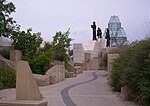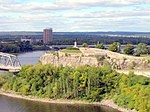National Gallery of Canada

The National Gallery of Canada (French: Musée des beaux-arts du Canada), located in the capital city of Ottawa, Ontario, is Canada's national art museum. The museum's building takes up 46,621 square metres (501,820 sq ft), with 12,400 square metres (133,000 sq ft) of space used for exhibiting art. It is one of the largest art museums in North America by exhibition space. The institution was established in 1880 at the Second Supreme Court of Canada building, and moved to the Victoria Memorial Museum building in 1911. In 1913, the Government of Canada passed the National Gallery Act, formally outlining the institution's mandate as a national art museum. The museum was moved to the Lorne building in 1960. In 1988, the museum was relocated to a new building designed for this purpose. The National Gallery of Canada is situated in a glass and granite building on Sussex Drive, with a notable view of the Canadian Parliament buildings on Parliament Hill. The building was designed by Israeli architect Moshe Safdie and opened in 1988.The museum's permanent collection includes over 93,000 works from European, American, and Asian, Canadian, and Indigenous artists. In addition to exhibiting works from its permanent collection, the museum also organizes and hosts a number of travelling exhibitions.
Excerpt from the Wikipedia article National Gallery of Canada (License: CC BY-SA 3.0, Authors, Images).National Gallery of Canada
Sussex Drive, Ottawa Lowertown (Rideau-Vanier)
Geographical coordinates (GPS) Address Phone number Website External links Nearby Places Show on map
Geographical coordinates (GPS)
| Latitude | Longitude |
|---|---|
| N 45.429444444444 ° | E -75.698333333333 ° |
Address
National Gallery of Canada
Sussex Drive 380
K1N 9N4 Ottawa, Lowertown (Rideau-Vanier)
Ontario, Canada
Open on Google Maps








